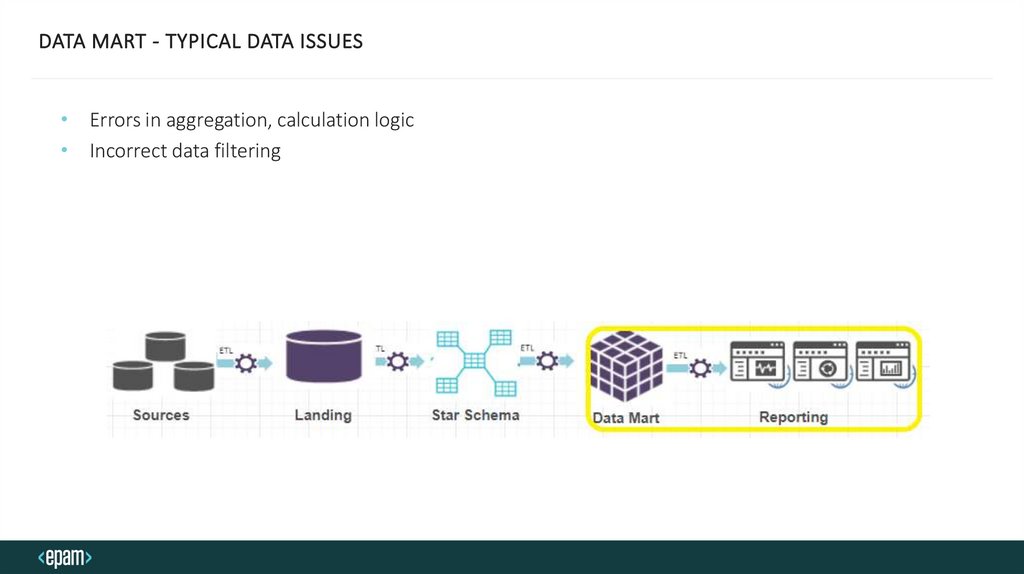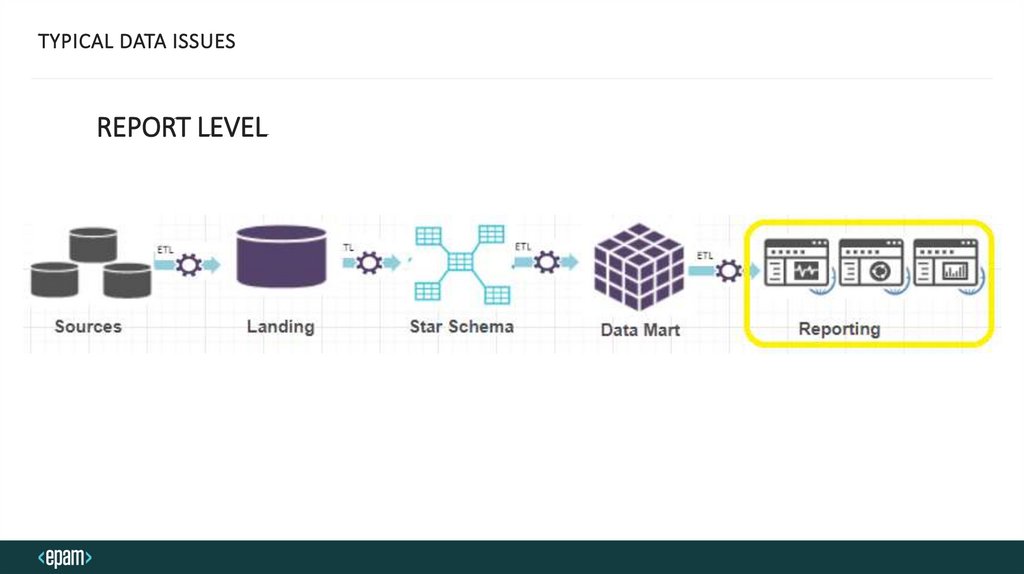Similar presentations:
DWH Testing Typical Data Issues (TESTING)
1.
AgendaDWH Testing
Typical Data Issues
2.
DWH TESTING3.
DATA SHOULD BE VERIFIED AT EVERY DWH LAYER4.
DQE WorkflowAnalyze
Requireme
nts
Define type
of loading
Perform
Data
Profiling
Define
environme
nt
Define data
to be used
for testing
Design of
test cases,
scenarios,
test data
Test
Execution
Result
Verification
with bug
reporting
Collecting
results for
regression
5.
DATA PROFILINGAnalyze source data before and after extraction to landing
extract representative data from each source file
parse data for the purpose of profiling
structure, relationship, data discovery
check for unusual cases
6.
DATA PROFILING – UNUSUAL CASES ExamplesWhen data loaded into DWH from 2 different databases (SQL Server, Maria DB) for one DB datetime will
be extracting for client time (Europe), and for other DB for source DB time (India), which can cause
discrepancies when uniting this datasets.
Different values in DB for same business key. For example we have 20201231 and 20200101 periods. We
need only year (and it's the same), but we also need to save MM and DD in the DB because it is standard
for all period in DB. How we should handle this situation, add new logic to capture both periods as one or
use UPDATE and make all values consistent?
We have only int values in a column dataID in source, but company that provides source to us keep this
column VARCHAR. How we make sure that it won't cause problems in future?
In source we have phone number +4402012345678, +44(020)12345678, 44(020)12345678, +44(020)1234-5678, +44(020)1234-5678, +44020-1234-5678, etc. And it is the same phone number.
7.
DATA PROFILING8.
SOURCE DATA PROFILING9.
SOURCE-LANDING DATA CHECK WITH DATA PROFLING• MIN, MAX, AVG… numeric values check
SOURCE
STAGING
10.
MAKING THE TEST ENVIRONMENT DECISIONA testing environment is a setup of software and hardware for the testing teams to
execute test cases
Do you need a separate QA env?
How many environments do you really need?
What is specific of these environments?
Is it possible to satisfy your request?
Working closely with DevOps team
11.
MAKING THE TEST DATA DECISIONWhat is it?
When we need it?
Advantages
Disadvantages
Synthetic data
Data that is artificially created rather
than being generated by actual
events.
To protect customer information
Required data does not exist
Required data has some gaps
No access to prod data
More efficient and cost effective
Cover missing cases in real data/ specific cases/
conditions
Increased flexibility
You are the only owner of your data
No secure risks
Using less data
If the system is complex it is a challenge to
create high quality synthetic data
Production data
A subset of production data to
represent a portion of the database
that is relevant to a test case
Complicated logic and dependencies
Historical data required
Performance testing
High quality software in case of complex systems
and dependencies
Ability to quickly reproduce client’s issue
Security violation: risk of exposing sensitive
user data
Email addresses, phone numbers, and the like
can be accidentally reach users by integration
tests
data is changing all the time, so it's more
difficult to write stable assertions
Production like data
Snapshot of production that has
been masked or obfuscated
Only production sensitive data can cover
requirements
Same as production data
legal or regulatory requirements mandate
anonymizing PII, patient data, financials, and so
on, which requires extra effort
Test data
End to end data created by test
team in full integration environment
No access to UAT
Extra efforts to create test data
12.
MAIN PROCESSES IN DWH TESTINGData Extraction – the data in the warehouse can come from many sources and of multiple data
format and types with may be incompatible from system to system. The process of data
extraction includes formatting the disparate data types into one type understood by the
warehouse. The process also includes compressing the data and handling of encryptions
whenever this applies;
Data Transformation – this processes include data integration, denormalization, surrogate key
management, data cleansing, conversion, auditing and aggregation;
Data Loading – after the first two process, the data will then be ready to be optimally stored in
the data warehouse;
Security Implementation – data should be protected from prying eyes whenever applicable as in
the case of bank records and credit card numbers. The data warehouse administrator
implements access and data encryption policies;
Job Control – this process is the constant job of the data warehouse administrator and his staff.
This includes job definition, time and event job scheduling, logging, monitoring, error handling,
exception handling and notification.
13.
DWH TESTING4
2
Data
Sources
2
Data
Ingestion
Data
Storage
ETL
bulk
stream
CDC
manual
upload
3NF
Data
Vault
ODS
BACK-END TESING
1
2
Meta
Model
Reporting &
Analytics
DWH
1. Metadata checks + data
formats, Profiling, LLD
2. Data: COUNT, MIN, MAX, AVG, SUM,
row-by-row comparison (subset)
Integrity: COUNT DISTINCT, NOT
NULL, Hash, data ranges
3. Reconciliation: Row-by-row
comparison
4. Reports data testing
Marts
star schema
calculation
engines
3
FRONT-END TESTING
Additional checks:
• Performance
• Security
• Error handling
• ETL run times (errors, warnings)
14.
MAIN FUNCTIONAL VALIDATIONS• Profiling /LLD/ Data
Validation
• Counts, Checksum
Validation
• End to End testing
Straight/Direct move
Data transformation
Look up validation
Filtering
Average Balance Calculation
Data integrity validation
External field validation
15.
SOME EXAMPLES16.
SOME EXAMPLES17.
VERIFY CLEANED DATAVerify corrected, cleaned, merged data
verify cleansing rules (check error tables, rejected records)
verify data merge, lookups
verify data integrity (check for duplicates, orphaned data)
verify data for renaming/reformatting
verify data transformations
18.
VERIFY CONSOLIDATED DATAVerify matched and consolidated data
• verify pivoting or loading data
• verify data completeness, quality
• verify joining data from multiple sources (e.g., lookup, merge)
19.
VERIFY DATA ON REPORTS LEVELVerify transformed/enhanced/calculated data
• verify sorting, pivoting, computing subtotals, adding view filters, etc.
(Reporting)
• verify that dimension and fact tables mapped correctly, therefore SQL
generated correctly (DM-Reporting)
• validate calculation logic against business requirements (write SQL for data
mart using calculation rules and compare data set (DM-Reporting)
20.
FRONT-END VERIFICATIONVerify front-end data
verify main functionality (export, scheduling, filters, etc.)
verify data on UI
verify presentation
verify performance (speed, availability, response time, recovery time, etc.);
21.
TYPICAL DATA ISSUES22.
TYPICAL DATA ISSUESDATA SOURCE LEVEL
23.
DATA SOURCE - TYPICAL DATA ISSUESInappropriate selection of candidate data sources
Unanticipated changes in source application
Conflicting information present in data sources
Inappropriate data entity relationships among tables
Different data types for similar columns (for example, addresslD is stored as a number in one table and a
string in another)
• Different data representation (The day of the week is stored as M, or Mon, and Monday in other
separate columns)
24.
DATA SOURCE - ISSUE EXAMPLE25.
TYPICAL DATA ISSUESSOURCE - LANDING LEVEL
26.
SOURCE-LANDING - TYPICAL DATA ISSUESDifferent data formats, column names
Some data can be missed or corrupted while capturing from data sources
Data comes in real-time
Performance - incremental and initial download
27.
SOURCE-LANDING - DATA ISSUE EXAMPLE28.
TYPICAL DATA ISSUESLND - DWH LEVEL
29.
DWH - TYPICAL DATA ISSUES• Incorrect business rules for data consolidation and merging: data inconsistency and data
incompleteness
• Loss of data during the ETL process (rejected records, refused data records in the ETL process)
• Missed errors
30.
TYPICAL DATA ISSUESDM LEVEL
31.
DATA MART - TYPICAL DATA ISSUES• Errors in aggregation, calculation logic
• Incorrect data filtering
32.
TYPICAL DATA ISSUESREPORT LEVEL
33.
DATA ANALYSIS LAYER – TYPICAL DATA ISSUESDimension and fact tables mapped incorrectly, therefore SQL generated incorrectly
Incorrect calculation of subtotals (especially if derived metrics used), KPIs, metrics, etc.
Incorrect behavior of some report manipulation techniques (drilling, sorting, export functions, etc.)
Performance issues (speed, availability, response time, recovery time, etc.)


































 management
management








